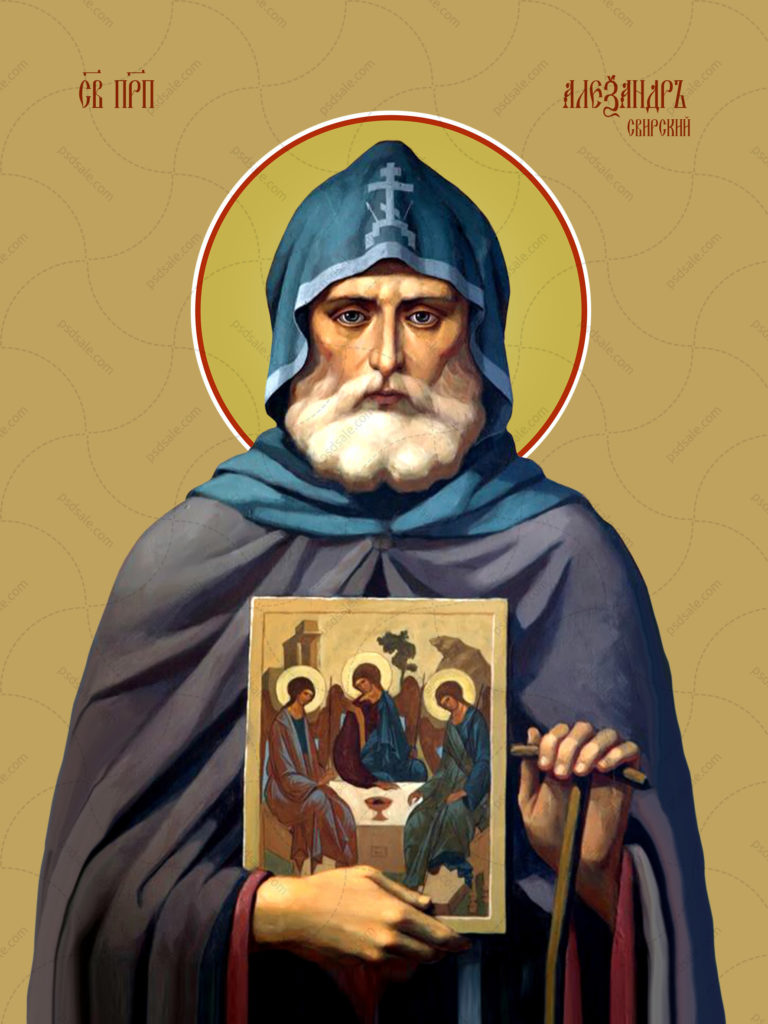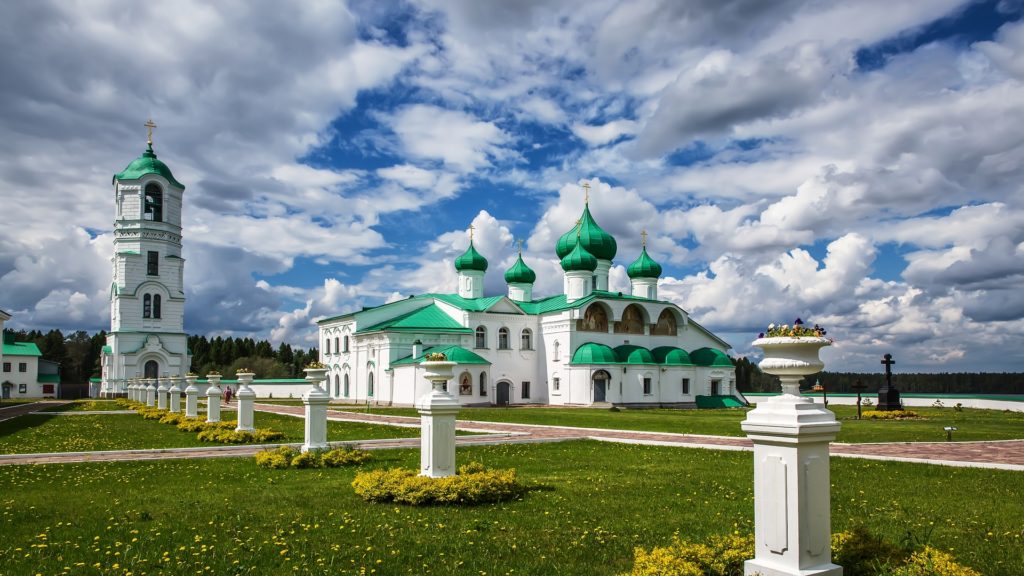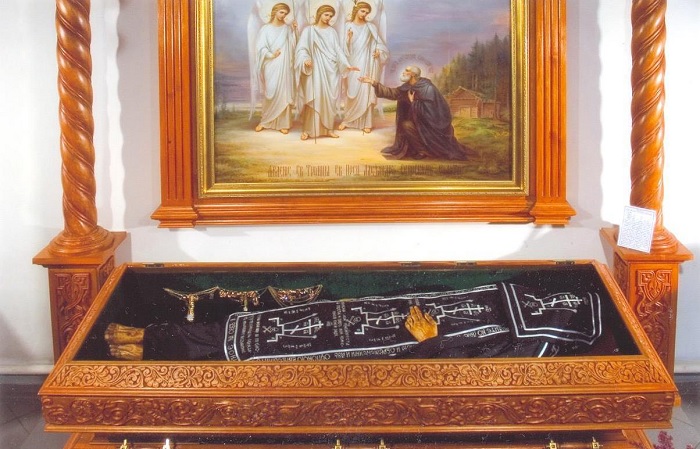When they listened to the prayer in the x-ray room of the forensic medical expertise after the end of the examination regarding the identification of the relics, the myrrh streaming began, which was followed by a strong divine fragrance. “All those present were witnesses of that miraculous event” – it is said in the report of the abbot of the Holy Trinity Alexander of Svir Monastery, Father Lucian, which he gave to Metropolitan Vladimir of St. Petersburg and Ladoga.
In the north-eastern corner of the Valamsky archipelago, there is the Holy Island open to all Ladoga winds. Here, in a cave hollowed out in the rock, five hundred years ago, Venerable Aleksandar of Svir was engaged in prayerful efforts. The cave is smaller. When you enter it, your back touches the rocks. The oil lamps of weak light that burn in front of the icons are enough to illuminate the surface of the cell. Venerable Alexander spent several years here. As it was said in the biography, “due to the great effort, the skin on his body became so tough, that it was not even afraid of the impact of a stone.” The saint was praying in a cave on the Holy Island when, in response to his prayers, the voice of the Holy Mother of God was heard: “Alexander! Get out of there and go to the place that was shown to you earlier, you can be saved there!” And the light disappeared… Venerable Alexander left the cave and behind the pine trees, which were standing on a steep rock, he saw the calm waters of Ladoga. A great heavenly light shone on that side where the Svir flowed.

On that day, the venerable Alexander left Valam and sailed to Svir. Here he stayed in the same place where he slept ten years ago on the way to the Valam Monastery. After some time, the saint’s prayerful solitude was interrupted by Prince Andrei Zavalishin, who had wandered off while hunting. Zavalishin questioned the reverend for a long time about how he lived here. “I have been living here for seven years – said the saint – and until your arrival I have not seen a single person. I feed on the grass that grows here and I have not eaten bread.”
When his solitude was broken, people started arriving here. Monks’ cells were built on the bank of the Holy Lake, and the reverend himself lived in the previous hut around which the brothers’ cemetery was built – Othadnaya Pustinja. Many students of Alexander Svirsky themselves became saints and founders of new monasteries. This was Andrei Zavalishin, who received the name of Andrian Andrusovsky during the monastic tonsure, then Gennadie and Nikifor Vazheozerski, Kornely Padanski, Terapont Voznesenski, Kasijan Solomenski… The entire area between Onega and Ladoga was consecrated to the monastic families they founded.
The power of the prayer of St. Alexander of Svir was unusual. Such an event is known. They built a log cabin on the canal between the two lakes, dug the isthmus and the water from the upper Holy Lake went down. The torrent was so strong that the monastery buildings were in danger and it seemed that nothing could save them, but the reverend invoked the name of Christ, made the sign of the cross over the flow of water and a miracle happened! – the flow stopped.
The Venerable’s clairvoyance was so great. Once the pilgrims gave their contributions to the monastery and among them was Grigorie who arrived from Pidmoser. He extended his hand to place his contribution but the saint pushed it away. Grigorie asked Alexander Svirsky why he did not receive alms. “Well, you don’t know me!” he said. “Right! – answered the saint – I do not know you and I have not seen your face, but your hand is so defiled that the stench spreads from it. Why are you beating your old mother?” Great fear then gripped Grigorie, who carefully hid his sin. He asked for advice on how to correct himself. The reverend advised him to seek forgiveness from his mother.

The venerable’s modesty was no less wonderful. They say that once, when he was already the abbot of the monastery he founded, the fame of which spread throughout Russia, the monastery’s treasurer came to him and said that they were running out of wood and that a free monk should be sent to the forest. “I am free” – answered the reverend, took the ax and went into the forest.
During the twenty-third year of his stay at the Holy Lake, Alexandar of Svir saw three men in white clothes, who were shining with a “vague light”, during the night prayer. This is what the Lord himself honored the saint with his appearance in the Trinity. “Alexander Svirsky – recorded in the History of the Russian Church, by Archimandrite Makarie (Veretenikov) – is a unique Orthodox saint, to whom the Holy Trinity appeared just like to Abraham.”
It is not certain whether this fact from the life of Venerable Alexander Svirsky was known by the people who occupied the power in Russia in 1917, but it is certainly known that they started their satanic campaign precisely from the Alexander-Svirsky monastery.
In the fall of 1918, the Olonets ČK sent a detachment under the command of August Wagner to the monastery. The monks tried to oppose the mocking of the holy relics, but the soldiers did not care. “Elements of an evil style”, as they called the monks, were arrested, the monastery was looted, and the tomb with the holy relics of Venerable Alexander Svirsky was hidden.
The preservation of the body of the venerable Alexander, who ended his earthly journey four hundred years ago, was so incomprehensible to Wagner that despite the obviousness in his report, he called the relics a “wax doll.” Not deciding to expose them as it should have been according to the instructions “in order to expose the priest’s deceptions”, the relics were secretly transported to the Lodeino valley with the fulfillment of all secrecy measures and placed in the hospital chapel with the strictest security. On November 5, 1918, when the monks of the Alexander-Svir monastery were shot in the courtyard of the Olonietskyi prison, the liquidation of the relics was also indicated… And for exactly eighty years, Orthodox Russia lived with the thought that the holy relics of the Russian saint were destroyed by satanic power. The Lord, again, did not allow this.
By the way, we will mention that the conquest of the Alexander-Svir monastery ended very sadly for August Wagner. The desecration of the venerable’s relics and the looting of the monastery caused a strong protest throughout Russia. Saint Patriarch Tikhon addressed Sovnarko and VCIK with protests. Explanations were requested from Olonjecka ČK. The head of the Central Committee replied that he considers all his actions and decrees “correct in the sense of merciless struggle with the enemies of communist ideas and socialist thought.”
This clarification would have completely satisfied the Bolshevik leadership in Moscow, if a very spicy fact had not been revealed during the correspondence: August Wagner, a fighter for communist ideas and socialist thought, proved to be very prone to theft. He took forty pieces of silver objects from the monastery and gave only nine to Moscow. The rest of the silver – thirty-one poods – was allegedly handed over “to the poor committee of the freed Alexander-Svir monastery for distribution among those who needed it.” For him to implement this plan, with such an explanation, it is understandable that it did not work. A special investigation was started with all the consequences that followed for Wagner.
The history of the search for the holy relics of the venerable Alexander Svirski, which was started by the nun Leonida with the blessing of father Lucian, the abbot of the Alexander-Svirski monastery, which was restored in 1997, deserves special attention. The main part of the documents was destroyed and it was necessary to look for the necessary facts from the remains.
“Our search,” says Mother Leonida, “was based on the belief that the relics of the saint who looked at the Holy Trinity face to face could not be destroyed by any infernal forces and that they are under the special protection of God.” Through archival searches, we were able to clarify that on January 31, 1919, the remains were exported from Lodeino field to Petrograd and placed in the closed anatomy museum of the Military Medical Academy. According to the testimonies of the workers, during the years of the revolution, an exhibit appeared in the main museum that remained unrecorded in the scrupulously compiled catalogs.
Source: “Russian House” magazine

